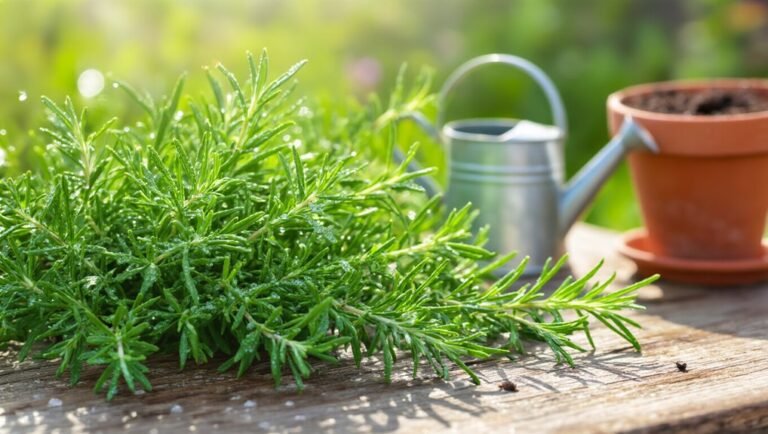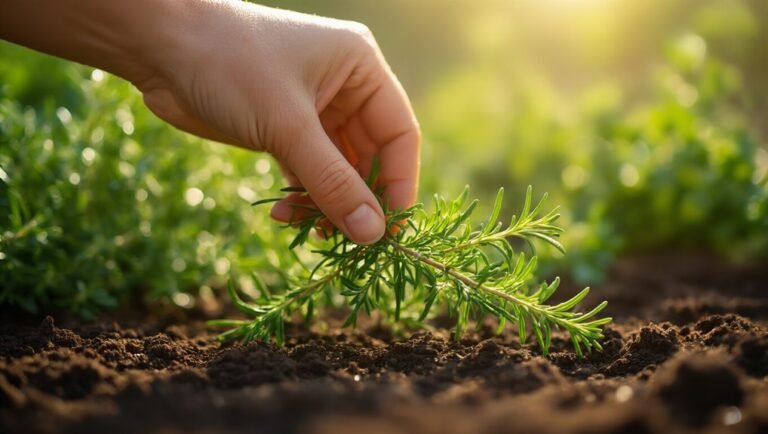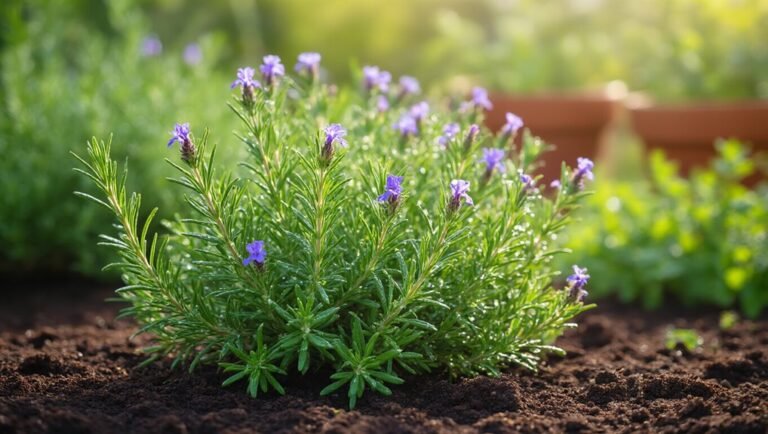To care for your jasmine flowers, ensure they get plenty of bright, indirect sunlight for at least six hours daily. Use well-draining, loamy soil mixed with organic matter and water regularly, allowing the top inch to dry out. Fertilize every 4 to 6 weeks during the growing season and watch for pests and diseases like root rot or mildew. By adjusting your care according to seasonal needs, you’ll encourage vibrant blooms and lush growth. Discover more tips for success!
Key Takeaways
- Provide jasmine plants with at least six hours of direct sunlight daily for optimal growth and flowering.
- Use well-draining, loamy soil mixed with organic matter to ensure healthy root development.
- Water jasmine regularly, allowing the top inch of soil to dry out between waterings to prevent root rot.
- Fertilize every 4 to 6 weeks during the growing season with a balanced, diluted fertilizer for robust growth.
- Maintain high humidity through misting or a humidifier, especially in warmer months, to promote healthy foliage.
Ideal Growing Conditions for Jasmine
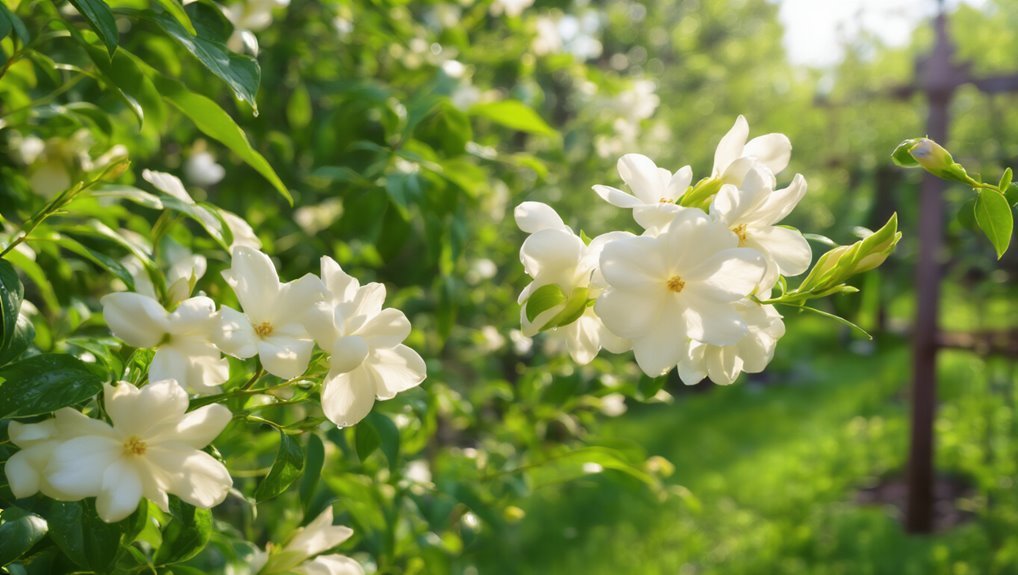
To ensure your jasmine thrives, you need to provide it with the right growing conditions.
Start by selecting a location that receives plenty of sunlight; jasmine loves bright, indirect light but can tolerate some shade. If you’re looking for a way to improve soil quality and drainage, consider planting jasmine in raised garden beds for enhanced root development.
Make sure you maintain a warm temperature, ideally between 65°F and 75°F, as jasmine flourishes in warmth.
Keep humidity levels high; daily misting or a humidifier can help, especially in drier climates.
Water your plant regularly, but don’t let it sit in soggy soil—allow the top inch to dry out between waterings.
Finally, support your jasmine with a trellis or stake if it’s a climbing variety, as this encourages healthy growth and beautiful blooms.
For optimal root health and easier maintenance, consider growing your jasmine in grow bags, which offer excellent drainage and aeration compared to traditional pots.
Following these tips will set your jasmine up for success.
Soil Requirements and Preparation
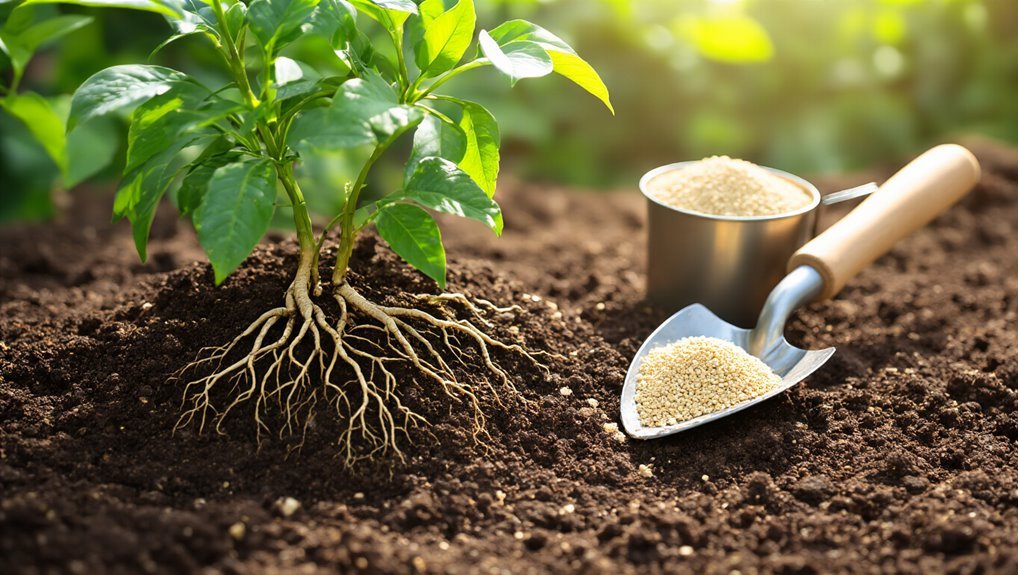
While jasmine can adapt to various soil types, it thrives best in well-draining, loamy soil enriched with organic matter. To prepare the soil for your jasmine, mix in compost or well-rotted manure to ensure the plants get the nutrients they need. Aim for a slightly acidic to neutral pH, around 6.0 to 7.0. Using compost bins can help you produce nutrient-rich compost right at home, supporting healthy jasmine growth.
Here’s a quick reference table to help you with soil preparation:
| Soil Component | Purpose | Recommended Ratio |
|---|---|---|
| Loamy Soil | Provides balance and drainage | 50% |
| Organic Matter | Nutrient-rich foundation | 30% |
| Sand or Perlite | Improves drainage | 20% |
For optimal results, consider using the best garden soil specifically designed to help your plants thrive.
Watering Practices for Healthy Growth
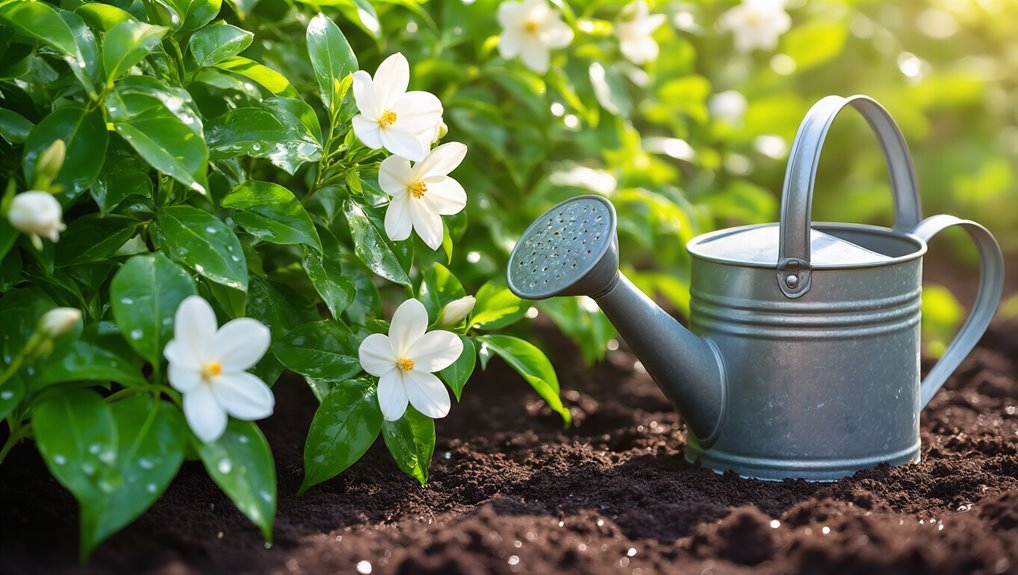
Watering your jasmine plants properly is crucial for their healthy growth and vibrant blooms. Make sure the soil stays consistently moist but not soggy. Using watering cans designed for gardeners can help you distribute water gently and evenly, preventing soil disturbance and root exposure. Check the top inch of the soil; if it feels dry, it’s time to water. Water deeply, allowing moisture to reach the roots, but avoid letting your plants sit in standing water.
During hot summer months, you might need to water more frequently, while cooler seasons require less. Use room temperature water to prevent shocking the roots.
If your jasmine is in a pot, ensure it has drainage holes to prevent waterlogging. Lastly, consider the humidity in your environment, as jasmine thrives in higher humidity levels, which can affect your watering schedule.
To help monitor moisture levels more accurately, you can use soil moisture sensors to ensure your garden’s soil remains optimal for thriving jasmine plants.
Sunlight Needs for Optimal Blooming
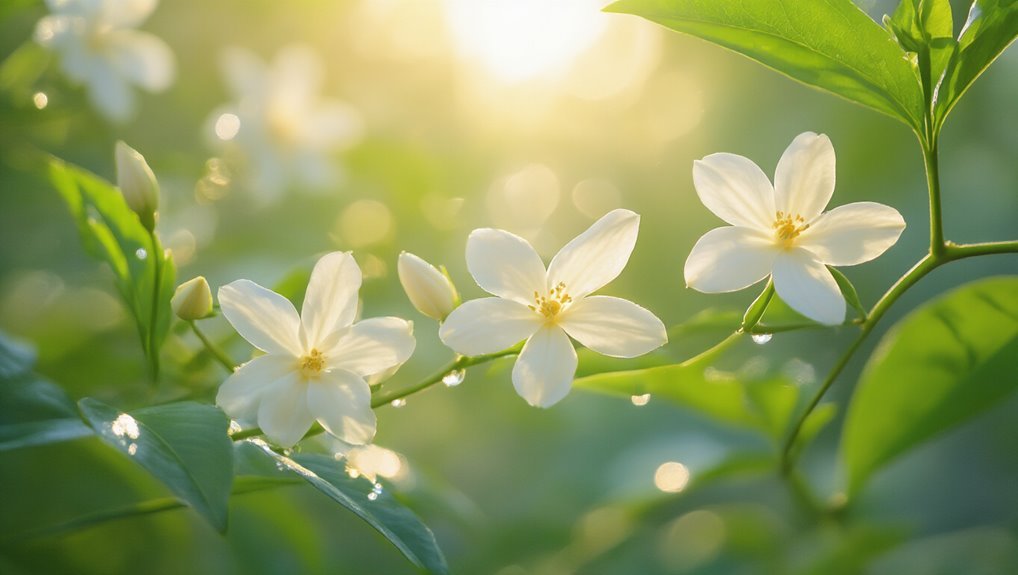
Providing your jasmine plants with the right amount of sunlight is essential for achieving lush blooms and vigorous growth.
Jasmine thrives best in full sun, so aim for at least six hours of direct sunlight each day. If you notice your plants stretching or becoming leggy, they mightn’t be getting enough light. To guarantee healthy growth and easy watering, consider using garden hose connectors that ensure a secure and leak-free fit for your irrigation setup.
On the flip side, too much harsh afternoon sun can scorch delicate leaves, especially in hotter climates. To strike a balance, consider placing your jasmine in a location where it receives morning sun and some afternoon shade.
Monitor your plants closely; if they’re not blooming as expected, adjusting their sunlight exposure can often make a significant difference.
When caring for your jasmine, using essential garden hoses makes watering more efficient and ensures your plants stay healthy.
Happy growing!
Fertilizing Your Jasmine Plants
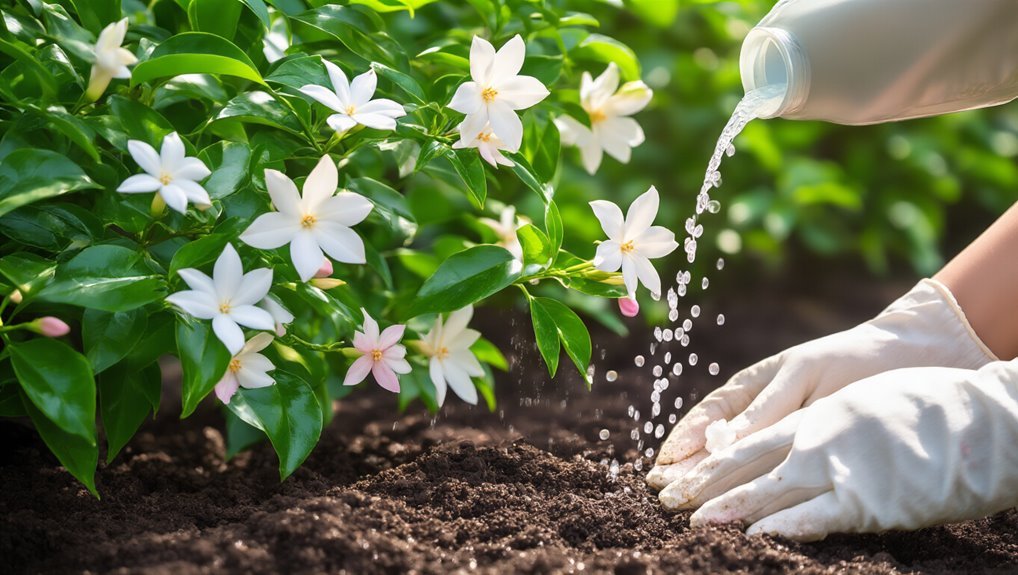
To ensure your jasmine plants thrive, it’s important to fertilize them regularly. Use a balanced, water-soluble fertilizer with an NPK ratio of 10-10-10 or similar. For a convenient feeding option, consider using plant fertilizer tablets, which release nutrients gradually and can boost overall plant health.
Aim to fertilize every 4 to 6 weeks during the growing season, typically spring through early fall. You can dilute the fertilizer to half strength to avoid over-fertilizing, which can damage the roots.
Pay attention to your plant’s response; if you notice yellowing leaves, you might be giving too much. Conversely, if growth seems slow, consider adjusting your fertilization schedule.
Always water your jasmine before applying fertilizer to prevent root burn. This way, you’ll support healthy foliage and abundant blooms throughout the season.
Many gardeners choose from the best plant food options to provide all the essential nutrients their jasmine plants need.
Enjoy the beauty of your thriving jasmine!
Pruning Techniques for Jasmine
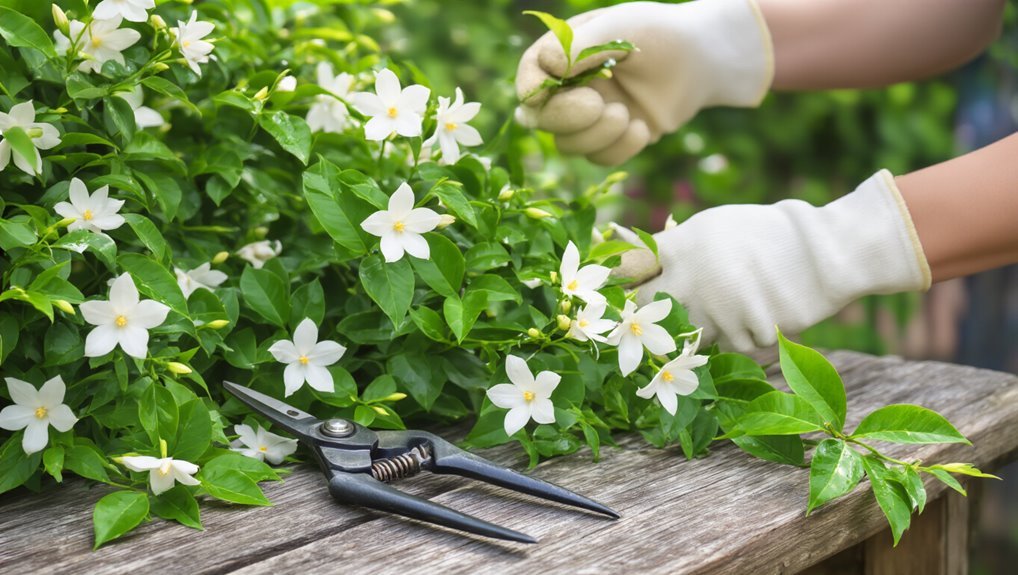
After ensuring your jasmine plants receive proper nourishment, it’s time to focus on pruning techniques that promote healthy growth and flowering.
Start by pruning in early spring, just before new growth begins. Remove dead or damaged stems to encourage fresh shoots. Aim to cut back about one-third of the plant, which helps maintain its shape and density. For gardeners, using the right hand rakes can make clearing fallen leaves and debris around your jasmine easier before you start pruning.
When pruning, make clean cuts just above a leaf node to stimulate branching. If your jasmine is climbing, train it by gently tying the stems to a support structure.
Regularly deadhead spent flowers to encourage more blooms. Remember, consistent pruning not only enhances your plant’s appearance but also supports its overall vitality and blooming potential.
For best results, use essential pruning shears to ensure precise and healthy cuts on your jasmine plant.
Happy pruning!
Pest Management and Prevention
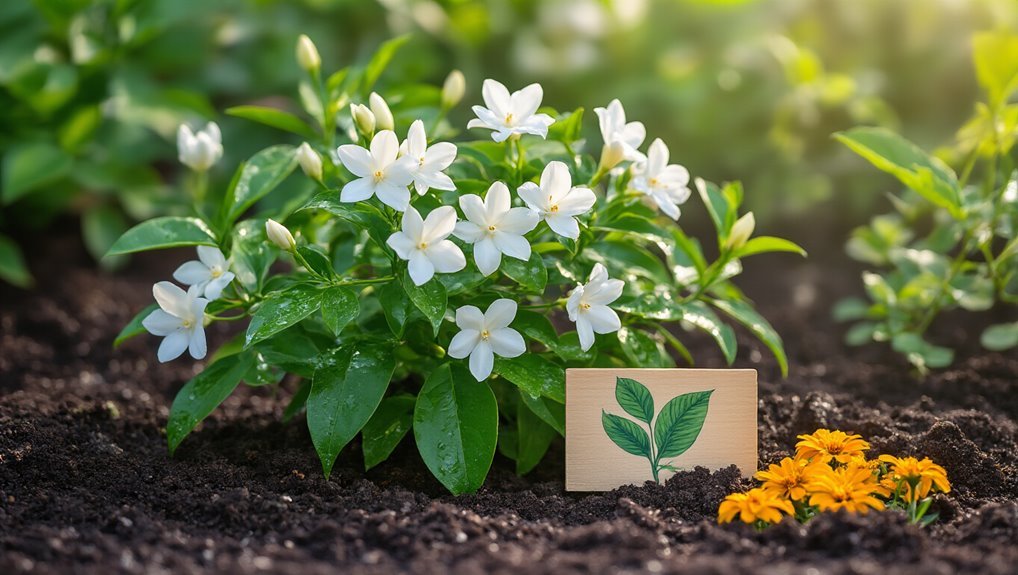
While enjoying the beauty of your jasmine plants, it’s crucial to keep an eye out for pests that can threaten their health. Common invaders like aphids, spider mites, and whiteflies can quickly damage your plants if left unchecked.
Regularly inspect your jasmine for any signs of infestation, such as discolored leaves or sticky residues. Garden Pest Traps can be a simple and effective way to monitor for early signs of pest activity and help keep pest populations under control. If you spot pests, act fast! You can wash them away with a strong stream of water or use insecticidal soap for more stubborn cases.
To prevent future infestations, maintain your plant’s health through proper watering, fertilization, and pruning. Additionally, introducing beneficial insects like ladybugs can help keep pest populations in check.
Using pest control products can offer an effective solution for managing severe infestations that can’t be controlled by natural methods alone.
A proactive approach will ensure your jasmine thrives beautifully.
Common Diseases Affecting Jasmine
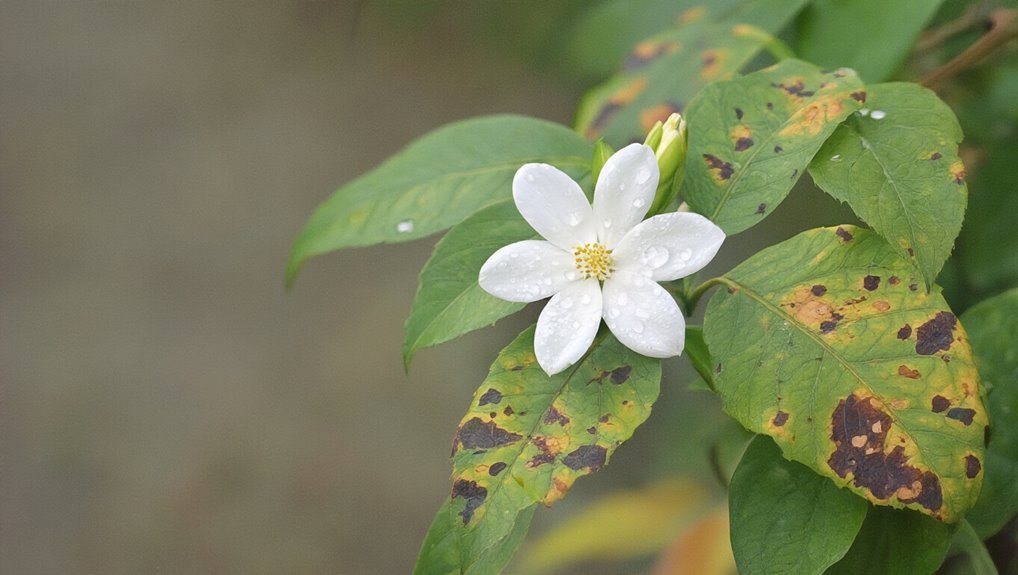
Even with diligent pest management, jasmine plants can still fall victim to various diseases that affect their health and beauty.
One common issue is root rot, often caused by overwatering and poor drainage. You’ll notice yellowing leaves and wilting, which are signs to adjust your watering schedule. Some gardeners choose to incorporate insect repellent plants nearby, as they can help deter pests and potentially reduce disease spread.
Powdery mildew is another foe; it appears as a white, powdery substance on leaves, thriving in humid conditions. To combat it, ensure proper air circulation and consider using a fungicide if necessary.
Additionally, jasmine may suffer from leaf spot disease, leading to brown or black spots on foliage. Maintaining good hygiene in your garden and promptly removing infected leaves can help prevent the spread of these diseases.
Using mulch in your garden can also promote healthier jasmine plants by improving moisture retention and soil quality, which helps reduce the risk of certain diseases.
Propagation Methods for Jasmine
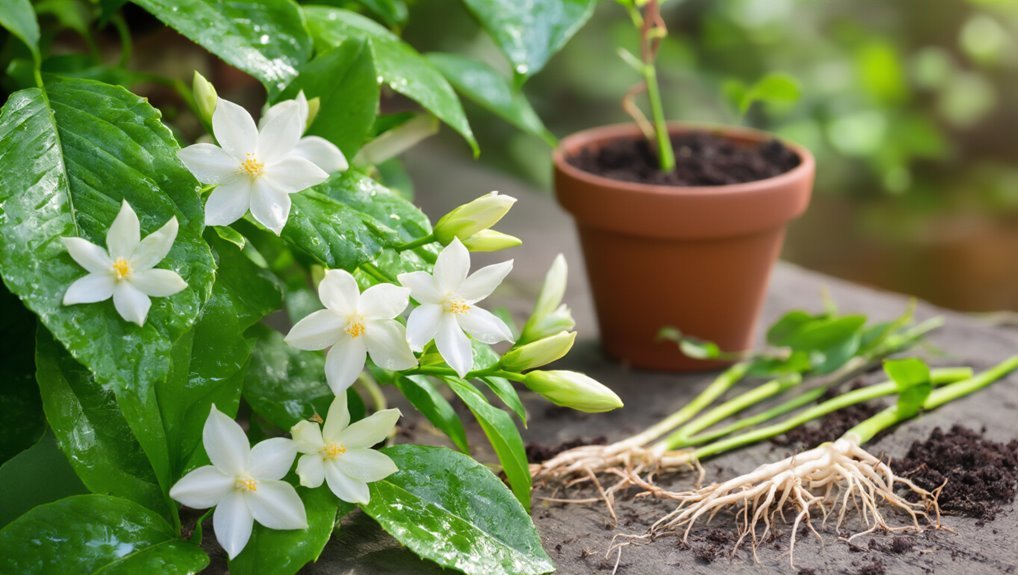
If you want to expand your jasmine collection, several effective propagation methods can help you achieve lush new plants.
One popular method is stem cuttings. Simply take a healthy cutting, about 4-6 inches long, and remove the lower leaves. Dip the cut end in rooting hormone and plant it in moist potting soil. Keep it in a warm, bright location and maintain humidity until roots develop. For best results, consider using seed starting kits designed to provide optimal conditions for young cuttings and seedlings.
Another method is layering. Bend a low-hanging stem to the ground, removing leaves where it touches the soil. Secure it with a stake, and cover it with soil, leaving the tip exposed.
Once roots form, you can separate it from the parent plant. Using a Plant Propagation Station can also make rooting cuttings more convenient and visually appealing, offering a stylish way to observe root development and grow new jasmine plants.
Try these methods, and you’ll soon enjoy more jasmine blooms!
Seasonal Care Tips for Jasmine
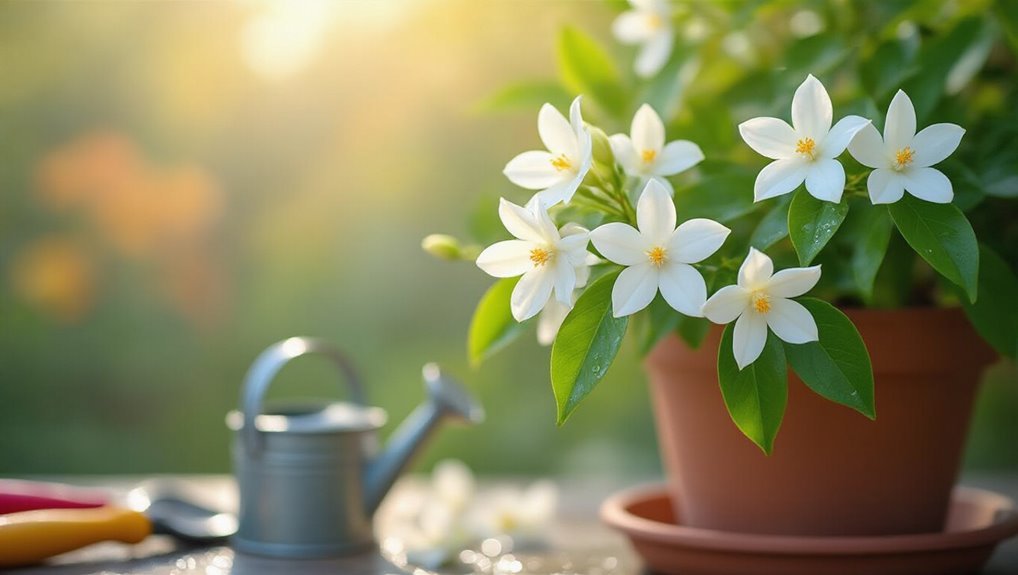
As the seasons change, adjusting your jasmine care routine is essential for maintaining healthy growth and vibrant blooms.
In spring, focus on repotting and fertilizing your jasmine to stimulate new growth. Make sure it gets plenty of sunlight, ideally 6-8 hours a day. For consistent soil hydration, some gardeners use wicking systems to ensure their jasmine receives a steady supply of water.
During summer, keep the soil consistently moist but not soggy, and consider misting the leaves to increase humidity.
As fall arrives, reduce watering as the plant enters dormancy. Trim back any dead or overgrown stems to encourage airflow.
In winter, protect your jasmine from frost by bringing it indoors if you live in a colder climate. Keep it in a well-lit area and water sparingly, allowing the soil to dry out between watering sessions.
For gardeners who want to make watering easier and more consistent, using self-watering planters can help maintain the ideal moisture level for jasmine plants throughout the year.
Frequently Asked Questions
Can Jasmine Flowers Be Grown Indoors Successfully?
Yes, you can grow jasmine flowers indoors successfully! Just ensure they receive plenty of sunlight, maintain humidity, and provide well-draining soil. Regular watering and occasional pruning will help keep your plants healthy and thriving.
How Long Does It Take for Jasmine to Bloom?
It usually takes about 3 to 4 months for jasmine to bloom after planting, depending on the variety and growing conditions. Keep the plant well-watered and in a sunny spot to encourage blooming.
What Are the Best Companion Plants for Jasmine?
Imagine planting jasmine alongside marigolds. These vibrant flowers not only enhance your garden’s beauty but also repel pests. For the best results, consider pairing jasmine with herbs like basil or rosemary, which thrive in similar conditions.
Can Jasmine Survive in Cold Climates?
Jasmine typically struggles in cold climates, but some varieties can tolerate mild frost. If you live in a colder area, consider providing protection, like mulch or bringing potted plants indoors during harsh weather.
How Do I Encourage More Blooms on My Jasmine Plant?
You might think jasmine blooms only in ideal conditions, but you can encourage more by ensuring proper sunlight, regular watering, and occasional fertilization. Pruning spent flowers also stimulates new growth, leading to abundant blooms.
Conclusion
By nurturing your jasmine plants with the right care, you’ll soon be enveloped in their sweet, intoxicating fragrance. Picture yourself stepping into a garden alive with delicate white blooms, their petals dancing gently in the breeze. With proper watering, sunlight, and attention to pests, you’re not just growing flowers; you’re cultivating a serene escape. So, embrace these tips, and let your jasmine flourish, turning your outdoor space into a fragrant paradise that enchants the senses.
